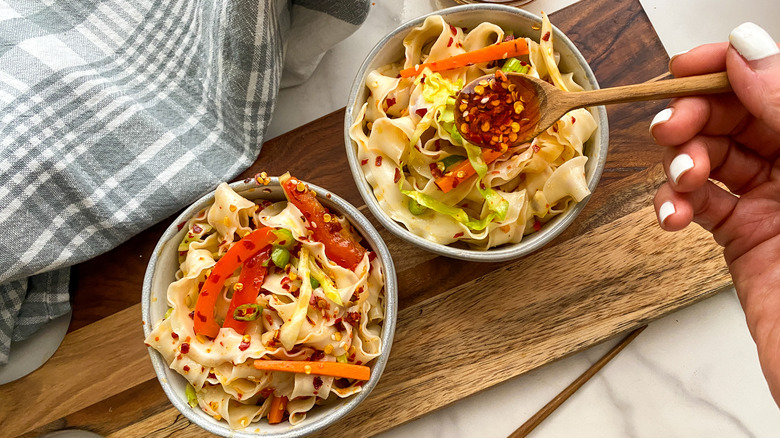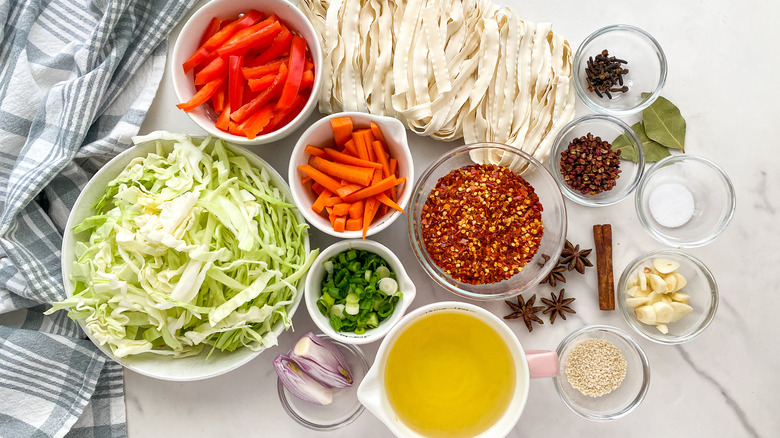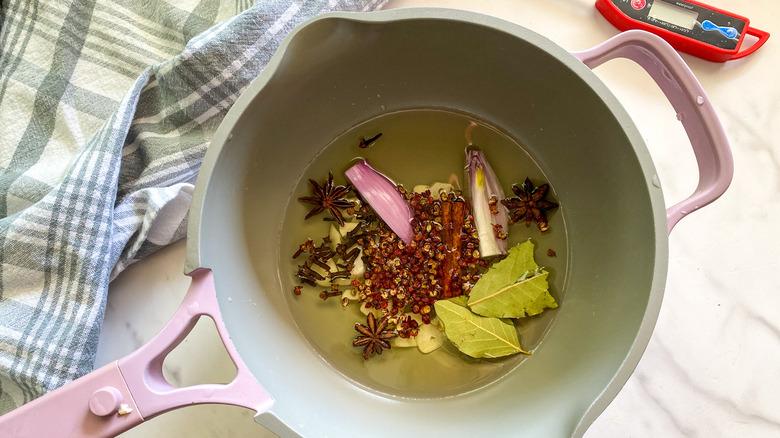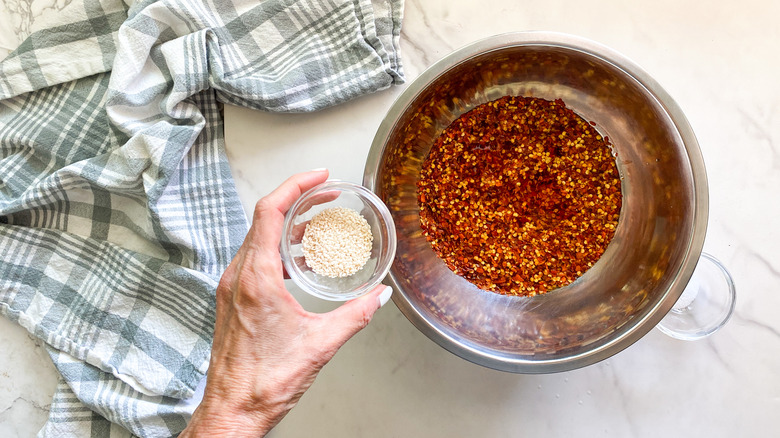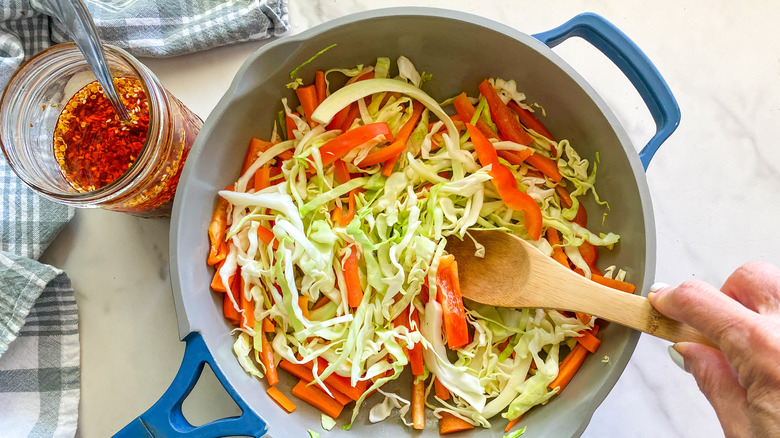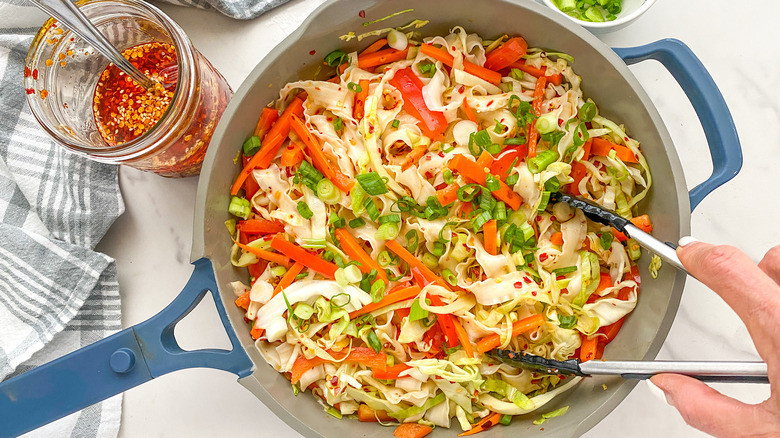Spicy Garlic Szechuan Noodles Recipe
Chinese cuisine is known for its diverse range of flavors, ingredients, cooking techniques and regional variations. Noodles play a central role in many dishes as they do in other cultures because of their popular taste and versatility. This spicy garlic Szechuan noodle recipe uses a homemade garlic chile oil and is inspired by Szechuan cuisine, which comes from the Sichuan Province of China.
Recipe developer Miriam Hahn brings us this recipe for spicy garlic Szechuan noodles and says, "Garlic chile oil is currently having a heyday on social media and is showing up in all sorts of dishes. This recipe makes extra chile garlic oil, and it will last well in your fridge for months so you can experiment with it on different things."
This noodle recipe pairs well with many Chinese entrees like grilled char siu or hot and sour soup. Read on to learn how to make this favored spicy dish from Sichuan!
Gather the ingredients for spicy garlic Szechuan noodles
To make this recipe, you'll need a few things that you can pick up an Asian market or order online. First is the Sichuan peppercorns. They are quite a bit different from standard peppercorns and have a hint of floral and pine flavor. Also important to this dish is Szechuan chili flakes, which are made from the dry husks of the Szechuan peppercorns. You can use any type of Chinese noodle in this recipe, and you will get a vast selection at an Asian market.
From the produce aisle, you'll need garlic, shallot, cabbage, red pepper, a carrot, and scallions. Some spices, sesame seeds, and oil finish off the list. Since you'll be cooking at high heat, grab some avocado oil, which has a high smoke point. The spices needed are star anise, bay leaves, whole cloves, a cinnamon stick, and salt. For the sesame seeds, you can use raw or roasted.
Infuse the oil
To start, you'll need to infuse the aromatics and spices into the oil. Grab a medium pot and pour in the oil. Then add the peppercorns, star anise, bay leaves, cloves, cinnamon stick, garlic, and shallots. Bring the heat to medium and test it with a food thermometer until it reaches the desired temperature between 225-250 F. "The spices can easily burn while they are in the oil, so it's important to monitor the temperature," Hahn explains.
Once the temperature is in the goal range, reduce the heat to low and let the aromatics and spices steep in the oil for 30 minutes. "It's a good idea to check the temperature a few times to make sure it is consistently holding at a temperature between 225 and 250 F.
Pour the oil over the chile flakes
While you're waiting, add the chile flakes to a heat-proof bowl. "A metal bowl works well if you have one," Hahn shares. When 30 minutes have passed, place a strainer over a bowl or directly over the bowl with the chile flakes, and pour in the hot oil. You can discard the aromatics and spices that have been collected in the strainer. Stir to combine, then add the salt and sesame seeds. Once this is cool, you can transfer it into a jar with a lid until you're ready to use.
Cook the noodles and vegetables
To start this step, begin cooking the noodles according to the package directions. While they're cooking, add the remaining oil to a large frying pan and add the cabbage, red pepper, and carrots. Bring the heat to medium and cook the vegetables for about 10 minutes stirring frequently. "The veggies will cook quickly because we want them bright in color and still crunchy," Hahn explains.
Toss everything and serve
When the vegetables are done, add the pasta to the pan along with some of the chile oil. "You'll need about ¼ to ½ cup of the chile oil, but add a small amount at first and give it a taste. The chile oil is on the spicy side so a little goes a long way," Hahn shares. For extra flavor, you can add some soy sauce, if desired. The leftover noodles and vegetables will last up to 4 days in the fridge and can be warmed up in the microwave or on the stove. Store the remaining chile oil in a jar with a lid in the fridge and it will keep for 6 months. Pretty soon you'll be adding it to everything!
Spicy Garlic Szechuan Noodles Recipe
This spicy garlic Szechuan noodle recipe uses a homemade garlic chile oil and is inspired by Szechuan cuisine, which comes from the Sichuan Province of China.
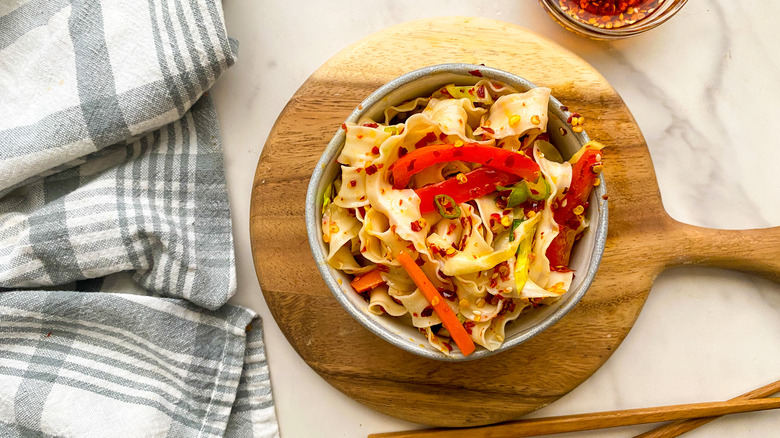
Ingredients
- 1 ½ cups avocado oil + 1 tablespoon, divided
- 1 tablespoon whole Szechuan peppercorns
- 4 star anise
- 2 bay leaves
- 1 teaspoon whole cloves
- 1 cinnamon stick
- 4 cloves garlic
- 1 shallot
- ¾ cup Szechuan chile flakes
- 1 teaspoon salt
- 2 teaspoons sesame seeds
- 8 ounces wide Chinese noodles
- 2 cups shredded cabbage
- ½ red pepper, sliced
- 1 carrot, julienne cut
- 3 scallions, chopped
Optional Ingredients
- Soy sauce
Directions
- Add the oil, peppercorns, star anise, bay leaves, cloves, cinnamon stick, garlic, and shallot into a medium pot.
- Bring the heat to medium.
- Test the oil with a food thermometer and when it gets to between 225-250 F, reduce the heat to low.
- Let the mixture steep for 30 minutes, checking a few times to make sure the temperature stays in the 225-250 F range.
- Pour the chile flakes into a metal or heat proof bowl.
- When the oil is done, strain out the whole spices, bay leaves, garlic, and shallots and discard.
- Pour the hot oil over the chile flakes. Stir well then add the salt and sesame seeds and set aside.
- Cook the noodles according to package directions.
- Heat up the remaining oil in a frying pan and add the cabbage, red pepper, and carrot. Sauté for 10 minutes on medium heat.
- When the pasta is done, toss with ¼ to ½ cup of the chile oil, the cooked vegetables, and scallions. Toss in some soy sauce for extra flavor, if desired.
- Store the remaining sauce in a sealed container for another use.
Nutrition
| Calories per Serving | 1,052 |
| Total Fat | 88.4 g |
| Saturated Fat | 10.9 g |
| Trans Fat | 0.0 g |
| Cholesterol | 47.6 mg |
| Total Carbohydrates | 61.6 g |
| Dietary Fiber | 10.1 g |
| Total Sugars | 6.6 g |
| Sodium | 591.5 mg |
| Protein | 12.3 g |
